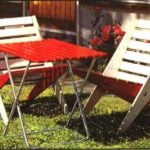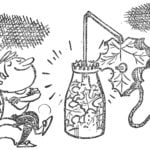Even in a small room, you can create a space for a sports corner, which is essential for the normal development of a child. “Club of Home Masters” has already introduced similar designs; today we offer another option, made entirely of wooden parts.
Interest in a “stadium” at home is enormous, especially for families with small children. And this is understandable—once a child starts walking, their activity becomes uncontrollable. The joys of parents turn into constant worries and running after their child, making sure they don’t get into trouble. Previous concerns related only to observing a “bedtime regimen” seem lighter and calmer.
To engage a child at this stage of life and instill a love for physical activity from childhood, a small home comprehensive trainer will help. Not everyone can afford to buy one in the store, and making one independently like industrial ones is also not accessible to everyone. The scarcity of materials and the lack of a machine park for a home master are also discouraging factors.
We propose to readers a simple children’s sports complex, for which only a few boards and rods of various diameters for shovels, sold in hardware stores, and elementary carpentry skills will be required. Cheap birch boards will be perfect—well-planed, they won’t leave splinters in the bodies of little athletes.
Home Sports Complex:
1 — rope, 2 — “spider web,” 3 — crossbar Ø 40 mm (3 pcs.), 4 — upper binding (boards 30X80 mm), 5 — “vines” (nylon cord Ø 12…15 mm), 6 — crossbar, 7— pole Ø 60 mm, 8 — swings, 9 — ladder, 10 — mounting bracket (2 pcs.), 11 — hanging ladder, 12 — rings.
The structure of the complex is shown in the figure above. The specific dimensions depend on the height of the room and the area allocated for the sports corner. The frame is assembled from boards with a cross-section of 30X80 mm.
It is better to start work with the “spider web.” In the vertical posts of the frame, grooves with a depth of 10 mm are selected, and holes with a diameter of 8 mm are drilled at a pitch of 100 mm. The same holes are made in the crossbars. The upper ends of the posts from the back side are fastened with a third crossbar. The frame, assembled with glue and screws, is tightened through the holes with an ordinary nylon cord for drying laundry. First, it is passed through the holes in the vertical elements of the frame, and then through the horizontal ones, tying knots at the intersections.
To make the ladder, holes are made in the other two posts along the entire length at intervals of 200 mm, in which crossbars — sticks with a diameter of 25…30 mm, cut to the required size — are fixed with casein glue. For attaching the ladder to the upper binding, notches of 30X80 mm are chosen on the posts.
The crucial parts are the crossbars in the upper frame used for hanging sports equipment. They should be made from bars with a diameter of at least 40 mm.
The complex is installed in the corner of the room. The upper frame of the frame is attached to the walls with wooden dowels using long screws (about 100 mm), and the bases of the vertical posts to the floor using metal brackets. To make the screws turn in without much effort, they need to be pre-soaked in household soap or ski wax.
After manufacturing, all parts should be carefully sanded and then covered with linseed oil two or three times with intermediate drying.
For children’s fun, rings, a rope, a pole, a trapeze, a rope ladder, rubber “vines” are hung on the crossbars. During classes, it is advisable to put homemade foam mats under the equipment, with a thickness of 200…300 mm.
And if you add a hanging crib to this structure, the complex will become a versatile children’s corner. Pine slats with a cross-section of 25X60 mm and 15X45 mm are taken for the frame. A frame with dimensions of 600X1250…1500 mm (according to the child’s height) is assembled from them. Protective grids are assembled from slats of 15X15 mm and 15X30 mm. The mattress is made of foam with a thickness of 25…30 mm according to the size of the frame and covered with a protective cover made of tapestry.
Of course, the equipment can be hung differently. Instead of the “spider web,” you can make a “real” Swedish wall. In any case, the child will get a lot of pleasure, and parents will have additional time for household chores.
A. SAMSONOV, Kostroma



